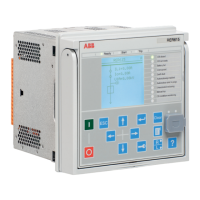of 160 ms is added to the transition from the bad quality. The bad quality of the
signal can be due to restrictions like:
• The source voltage is below 0.02 × U
n
at F
n
.
• The source voltage waveform is discontinuous.
• The source voltage frequency rate of change exceeds 15 Hz/s (including stepwise
frequency changes).
When the bad signal quality is obtained, the nominal or zero (depending on the
Def frequency Sel
setting) frequency value is shown with appropriate quality
information in the measurement view. The frequency protection functions are
blocked when the quality is bad, thus the timers and the function outputs are
reset. When the frequency is out of the function block’s setting range but within
the measurement range, the protection blocks are running. However, the OPERATE
outputs are blocked until the frequency restores to a valid range.
11.5 Measurement modes
In many current or voltage dependent function blocks, there are various alternative
measuring principles.
• RMS
• DFT which is a numerically calculated fundamental component of the signal
• Peak-to-peak
• Peak-to-peak with peak backup
Consequently, the measurement mode can be selected according to the application.
In extreme cases, for example with high overcurrent or harmonic content, the
measurement modes function in a slightly different way. The operation accuracy
is defined with the frequency range of f/fn=0.95...1.05. In peak-to-peak and RMS
measurement modes, the harmonics of the phase currents are not suppressed,
whereas in the fundamental frequency measurement the suppression of harmonics
is at least -50 dB at the frequency range of f= n x fn, where n = 2, 3, 4, 5,...
RMS
The RMS measurement principle is selected with the
Measurement mode
setting
using the value "RMS". RMS consists of both AC and DC components. The AC
component is the effective mean value of the positive and negative peak values.
RMS is used in applications where the effect of the DC component must be taken
into account.
RMS is calculated according to the formula:
(Equation 88)
n
The number of samples in a calculation cycle
I
i
The current sample value
1MRS758755 C General function block features
REC615 & RER615
Technical Manual
827

